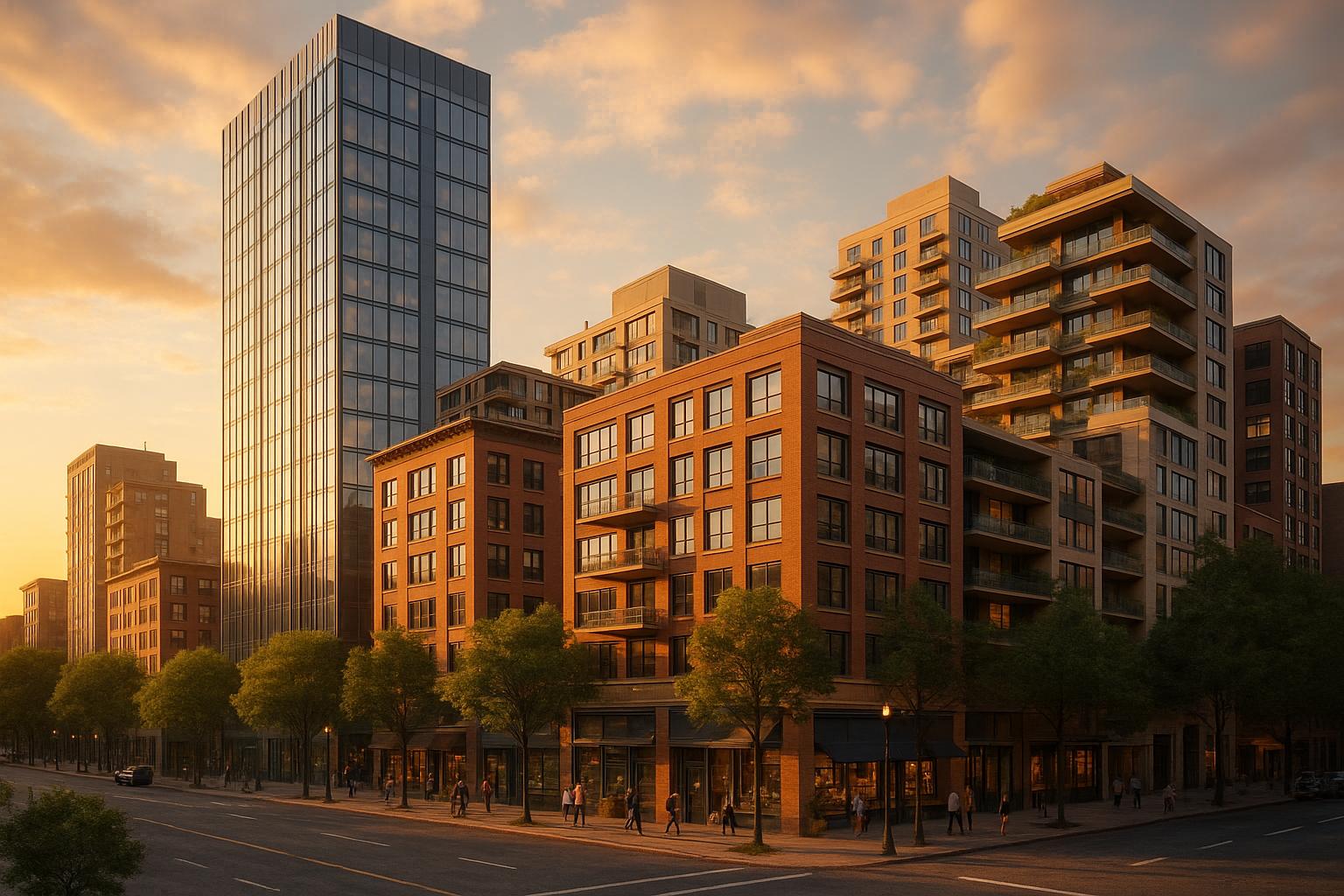Famous buildings are more than just pretty structures - they're architectural icons that shape our world. Here's what you need to know:
- Famous buildings boost tourism and local economies
- They create jobs and can transform entire cities
- Many are UNESCO World Heritage Sites
- They connect us to history and culture
- Some face challenges with preservation costs and environmental concerns
Top 10 famous buildings covered in this article:
- Pyramids of Giza
- Parthenon
- Colosseum
- Notre-Dame Cathedral
- Taj Mahal
- Eiffel Tower
- Empire State Building
- Sydney Opera House
- Burj Khalifa
- Guggenheim Museum Bilbao
Quick comparison of key features:
| Building | Location | Year Built | Height | Annual Visitors |
|---|---|---|---|---|
| Pyramids of Giza | Egypt | ~2630 BC | 146 m | 14.7 million |
| Parthenon | Greece | 447-432 BC | 13.7 m | 7.2 million |
| Colosseum | Italy | 70-80 AD | 48 m | 7.6 million |
| Notre-Dame | France | 1163-1245 | 69 m | 12 million (pre-2019) |
| Taj Mahal | India | 1632-1653 | 73 m | 6-8 million |
| Eiffel Tower | France | 1887-1889 | 324 m | 7 million |
| Empire State | USA | 1930-1931 | 443 m | 4 million (observation deck) |
| Sydney Opera House | Australia | 1959-1973 | 65 m | 10.9 million |
| Burj Khalifa | UAE | 2004-2009 | 828 m | 2 million (observation deck) |
| Guggenheim Bilbao | Spain | 1993-1997 | 50 m | 1 million |
These iconic structures continue to captivate visitors and inspire new architectural innovations worldwide.
Related video from YouTube
How Building Styles Changed Over Time
Building styles have changed a lot since ancient times. Let's take a quick tour through history:
Ancient Egypt (3100 BC - 30 BC): Think BIG and symmetrical. The Pyramids of Giza? Yeah, that's what we're talking about.
Greek architecture (8th - 4th century BC): Columns, columns everywhere. The Parthenon is the poster child for this style.
Roman architecture (1st century BC - 5th century AD): Greeks 2.0, but with arches and domes. Check out the Colosseum for a prime example.
Gothic architecture (12th - 16th century AD): Reaching for the sky with pointy bits. Notre-Dame Cathedral shows off this style's flair for the dramatic.
Renaissance (14th - 17th century AD): Back to basics with a classical twist. St. Peter's Basilica nails the symmetry game.
Modern architecture (early 20th - mid-20th century): Function over frills. The Empire State Building stands tall as an Art Deco icon.
Contemporary architecture: Anything goes, with a side of high-tech. The Burj Khalifa in Dubai? It's not just tall, it's TALL.
Each era built on the last, giving us the mix of styles we see in famous buildings today. It's like a giant, global game of architectural telephone.
Stories Behind Well-Known Buildings
Famous buildings aren't just pretty. They've got wild stories. Let's dive in:
Sydney Opera House: Born from an orange peel. No joke. Jørn Utzon saw those curved segments and BAM - sail-like design. But it wasn't smooth sailing:
- 200+ design entries
- 14 years to build (1959-1973)
Eiffel Tower: Parisians HATED it at first. Built for the 1889 World's Fair. Fun fact: Eiffel didn't design it. His engineers did. It stuck around because it made a great radio antenna.
Taj Mahal: Love story in stone. Took 20,000 workers and 20 years (1632-1653). During WWII, they got creative:
| What They Did | Why |
|---|---|
| Covered it in bamboo | To fool bombers |
| Kept it up | All through WWII |
Parthenon: This 2,500-year-old building's been around the block:
1. Greek temple for Athena
2. Christian church
3. Catholic church
4. Mosque
5. Gunpowder storage (bad idea - it exploded in 1687)
Guggenheim Museum Bilbao: Inspired by... fish. Gehry wanted that shimmery, twisty look. Used titanium to mimic scales.
Lotus Temple: In New Delhi, it's shaped like a lotus flower. 27 marble "petals" in groups of three. Meant to scream unity and peace.
These buildings? They're not just stone and metal. They're wild ideas turned real.
Pyramids of Giza
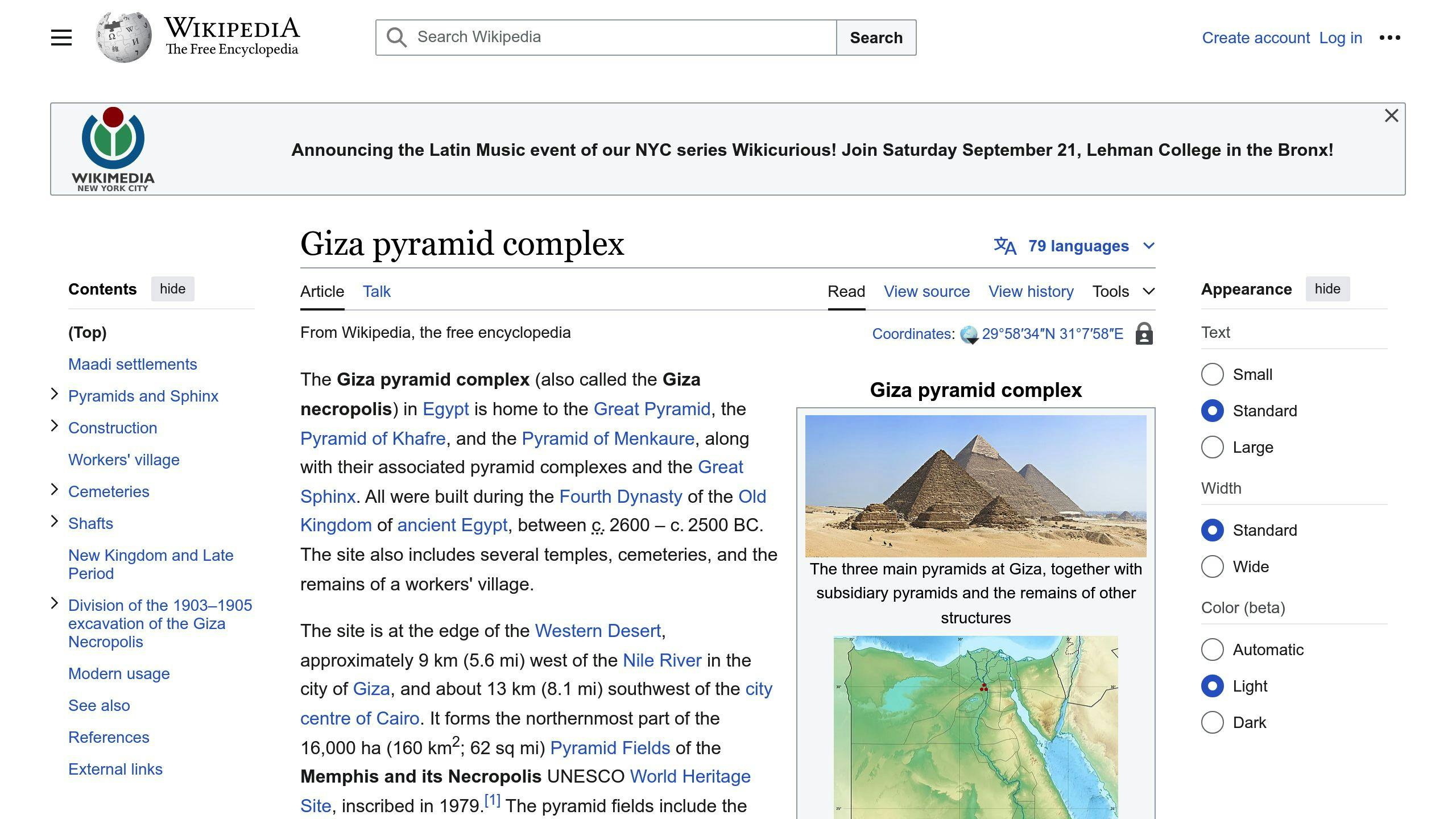
The Pyramids of Giza are a BIG DEAL. Why? They're the last ancient wonder still standing.
Built over 4,500 years ago, these massive structures show off what ancient Egyptians could do. The Great Pyramid of Khufu was the tallest thing humans ever built for 3,800 years. It's shorter now (137 meters), but still jaw-dropping.
Building Smarts
The ancient Egyptians weren't messing around. Check this out:
| What They Did | How They Did It |
|---|---|
| Perfect alignment | Lined up with the Temple of Ra and Orion's Belt |
| Smart materials | Yellow limestone core, fancy light limestone outside |
| Massive scale | Great Pyramid: ~2.3 million blocks, each 2.5-15 tons |
| Quick work | Built the Great Pyramid in just 10-20 years |
These guys knew their stuff: math, stars, and building big.
Cultural Impact
The Pyramids are a big deal for Egypt and the world:
- Tourists LOVE them
- UNESCO says they're special
- Scientists are still finding new stuff
Famous? You Bet
Everyone knows the Pyramids:
- Symbol of Egypt? Check.
- In movies and books? Yep.
- Taught in schools? You know it.
"After 4,500 years, Egypt's Pyramid Plateau deserves an upgrade." - Euronews
Looks like even after all this time, people still can't get enough of the Pyramids.
2. Parthenon

The Parthenon isn't just an old building. It's a 5th century BCE powerhouse of Greek culture sitting pretty on Athens' Acropolis.
Why's it a big deal? Let's break it down:
| Aspect | Why It Matters |
|---|---|
| Political | Showed off Athens' big-shot status |
| Cultural | Peak Greek art and architecture |
| Religious | Athena's VIP house |
| Historical | 2,500+ years of seeing it all |
The Parthenon brought some cool tricks to the building game:
- Optical illusions? Check. Subtle curves make it look perfect from afar.
- Doric order's poster child? You bet.
- Smart material choice? Pentelic marble that glows golden in sunlight.
But it's not just about the building. The Parthenon's got cultural clout:
1. It's been artists' muse for centuries.
2. It's basically democracy's mascot.
3. It's Athens' cash cow, pulling in tourists by the millions.
How famous is it? Let's put it this way:
- UNESCO World Heritage? Yep.
- On Greek euros? You know it.
- Tourist magnet? Absolutely.
"The Parthenon's not just a pretty face on a hill. It's a cultural and historical heavyweight." - Josh Burleson, Author
Bottom line: The Parthenon shows what happens when humans go all out. It's not just famous for its looks, but for what it represents.
3. Colosseum

The Colosseum isn't just a big old building. It's a 2,000-year-old marvel that STILL influences how we build today.
Why It's Important
Built between 70-80 AD, this massive amphitheater could pack in up to 80,000 spectators. That's like filling a modern NFL stadium - but 2,000 years ago!
| Feature | Detail |
|---|---|
| Original Name | Flavian Amphitheater |
| Construction Period | 72-80 AD |
| Seating Capacity | 50,000-80,000 |
| Annual Visitors (2019) | Over 7 million |
But size isn't everything. The Colosseum was:
- A political tool (free entertainment = happy citizens)
- An architectural game-changer
- A symbol of Rome's power (and brutality)
New Building Ideas
The Colosseum wasn't just big - it was smart:
1. Efficient Design
Elliptical shape and tiered seating? Better views and crowd control. Ancient Romans knew how to handle a mob.
2. Underground Magic
The hypogeum (fancy word for "underground tunnels") let gladiators and animals pop up like deadly jack-in-the-boxes.
3. Comfort for the Masses
A giant, retractable awning kept spectators from roasting. It took 100 sailors to operate. Talk about a high-maintenance roof!
Effect on Culture
The Colosseum was Rome's entertainment hub:
- Hosted epic parties (100-day opening bash, anyone?)
- Shaped Roman entertainment for centuries
- Inspired art and architecture worldwide
"The Colosseum isn't just an old building. It's a time machine that shows us Roman engineering genius and their love of spectacle." - Filippo Coarelli, Professor of Roman Antiquities
How Well-Known It Is
The Colosseum's fame keeps growing:
- New Seven Wonders of the World? Check.
- 7 million visitors in 2019? Double check.
- Featured on Italian euro coins? Triple check.
Recent buzz:
- $30 million facelift (2013-2021)
- Ongoing discoveries in the hypogeum (ancient Roman secrets, anyone?)
The Colosseum isn't just ancient history. It's a living reminder of Rome's past glory and a magnet for millions of tourists. Not bad for a 2,000-year-old building, right?
4. Notre-Dame Cathedral
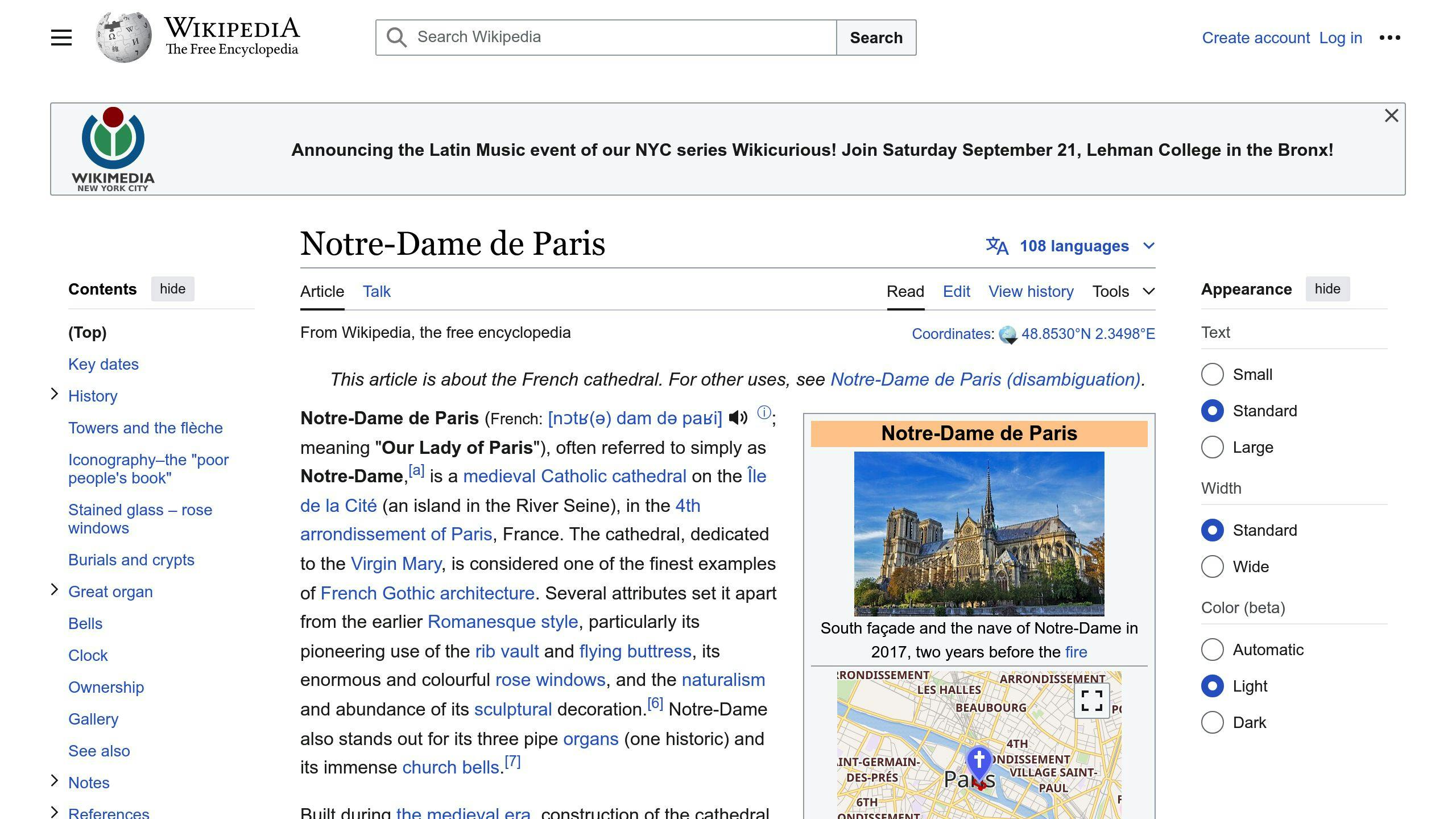
Notre-Dame isn't just a pretty face. This 850-year-old Parisian icon has seen it all: royal coronations, imperial weddings, and millions of tourists with their jaws on the floor.
| Feature | Detail |
|---|---|
| Construction Started | 1163 |
| Completion | ~1345 (main structure) |
| Height | 315 feet (96 meters) |
| Annual Visitors (pre-2019) | 12-13 million |
What's the big deal? Think Gothic architecture on steroids. We're talking flying buttresses, massive rose windows, and enough history to fill a library.
But Notre-Dame isn't just old stones. It's inspired art, literature, and countless selfies. Victor Hugo even wrote a whole book about it (you might've heard of "The Hunchback of Notre Dame").
Then 2019 happened. The fire that nearly took Notre-Dame down shocked everyone. But here's the kicker: it also sparked a global restoration effort that's nothing short of amazing.
- €846 million raised from 340,000 donors in 150 countries
- 1,000 historic French oak trees for the new spire
- Reopening date: December 8, 2024
"By the time the Olympic Games come around (in July), we expect to have un-scaffolded the upper part of the spire and completed most of the roofing, so that Parisians and visitors from all over the world can see just how close the cathedral is to reopening." - Philippe Jost, Rebuilding Notre Dame de Paris
This isn't just about fixing an old building. It's about keeping a piece of history alive for future generations to gawk at, just like we did.
5. Taj Mahal
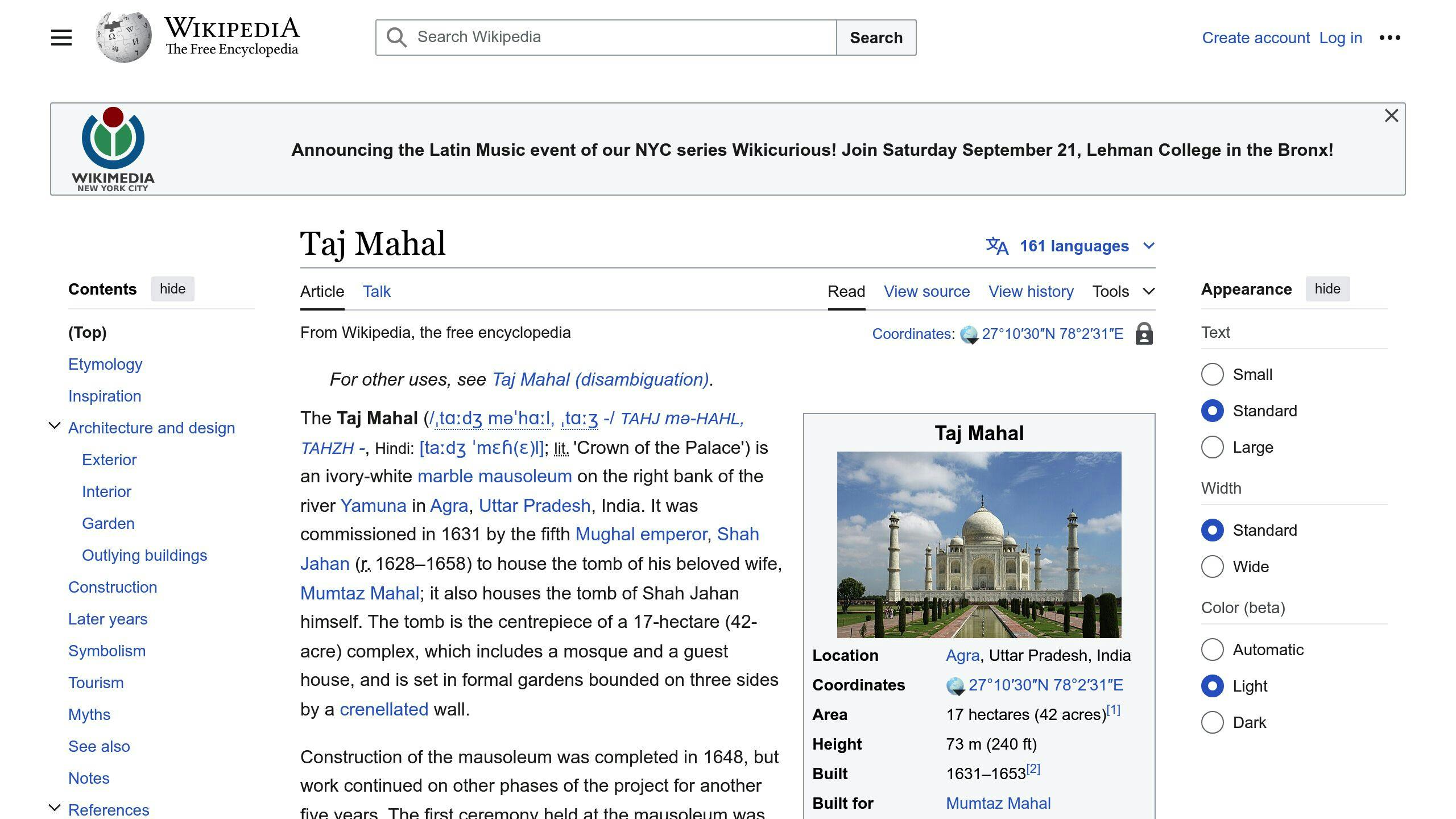
Why It's Important
The Taj Mahal isn't just a pretty building. It's a 17th-century masterpiece that blends Indian, Persian, and Islamic styles. Shah Jahan built it as a tomb for his wife Mumtaz Mahal.
Quick facts:
- Built from 1632 to 1643
- Over 20,000 workers from various regions
- Cost: 32 million rupees (about $827 million today)
Why care? It's more than old stones. The Taj Mahal is a symbol of love and an engineering marvel that's puzzled architects for centuries.
Effect on Culture
The Taj Mahal is a cultural icon. It's inspired everything from poetry to pop culture.
Poet Rabindranath Tagore called it "A Teardrop on the Cheek of Time."
Cultural impact:
- UNESCO World Heritage Site (1983)
- Modern Wonder of the World
- Attracts 2-4 million visitors yearly (200,000 international)
How Well-Known It Is
The Taj Mahal is the Brad Pitt of buildings. Everyone knows it, even if they've never been to India.
Visitor stats:
| Year | Visitors | Revenue from Entry Tickets |
|---|---|---|
| 2013 | 5.8 million | - |
| 2014 (up to September) | 4.25 million | Rs 21.84 crore |
Fun fact: The Taj changes colors throughout the day. It's pearly gray at sunrise, white at noon, orange-bronze at sunset, and blue in the evening.
The Taj Mahal is history, art, and human achievement rolled into one. Whether you're into architecture, romance, or just cool stuff, it's got something for you.
sbb-itb-1be9014
6. Eiffel Tower

The Eiffel Tower isn't just a big hunk of metal. It's a game-changer that put Paris on the map.
Why It's Important
Built in 1889, this 324-meter iron giant was the world's tallest structure for 41 years. But here's the kicker: it was supposed to be temporary.
Some quick facts:
- 18,038 metal parts
- 2,500,000 rivets
- Built in just over 2 years
New Building Ideas
Gustave Eiffel and his team weren't messing around. They used iron to make something strong yet light.
| What | How |
|---|---|
| Base | 125-meter square |
| Height | 300 meters |
| Material | Puddle iron |
| Workers | 300-450 total |
Effect on Culture
The Eiffel Tower is everywhere. Movies, photos, art - you name it. It's not just a tower; it's a symbol of romance and French flair.
It's inspired:
- 50+ copycat towers worldwide
- Scientific breakthroughs (they found cosmic rays here!)
How Well-Known It Is
Everyone and their grandma knows the Eiffel Tower. It's THAT famous.
| When | How Many Visitors |
|---|---|
| 1889 | 2 million |
| Now (yearly) | 7 million |
Gustave Eiffel wasn't just about function. He said:
"For my part I believe that the Tower will possess its own beauty. Are we to believe that because one is an engineer, one is not preoccupied by beauty in one's constructions, or that one does not seek to create elegance as well as solidity and durability?"
The Eiffel Tower went from "tear it down" to "can't live without it". It's the heart of Paris, pulling in millions of tourists and their wallets every year.
7. Empire State Building

The Empire State Building isn't just a skyscraper. It's a New York icon that's been turning heads since 1931.
At 1,454 feet (with its antenna), this 102-story giant held the "world's tallest" title for 40 years. But it's not just about height. This building is packed with cool facts:
- Built in a speedy 20 months
- Designed by William F. Lamb
- Constructed at a rate of 4.5 stories per week
The builders weren't just fast - they were smart. They used a steel frame covered in limestone and granite. And get this: they planned for a mooring mast for airships at the top. Talk about thinking big!
| Feature | Detail |
|---|---|
| Height | 1,454 feet (with antenna) |
| Stories | 102 |
| Elevators | 73 |
But the Empire State Building is more than just an engineering marvel. It's a cultural icon:
- Star of over 90 movies (King Kong, anyone?)
- Host to an annual stair-climbing race (1,576 steps!)
- Lights up for events and holidays
During elections, it even becomes a giant scoreboard, lighting up with the new President's face.
The building's fame isn't just local. It draws 4 million visitors to its observation deck every year. It's been a National Historic Landmark since 1986. And it's not just for tourists - major companies like LinkedIn and Shutterstock call it home.
The Empire State Building proves that great architecture stands the test of time. It's more than a building - it's a symbol of New York and human ambition.
8. Sydney Opera House

The Sydney Opera House isn't just a building. It's Australia's calling card to the world.
Perched on Sydney Harbour, this architectural wonder has been turning heads since 1973. Why? It's all about those white "sails" that make up its roof.
Danish architect Jørn Utzon dreamed up this bold design back in 1957. He won an international competition, and the rest is history.
| Quick Facts | |
|---|---|
| Where | Sydney Harbour, Australia |
| Who | Jørn Utzon |
| When | Opened October 20, 1973 |
| What | UNESCO World Heritage Site (2007) |
Breaking New Ground
The Opera House wasn't just pretty. It was revolutionary:
- One of the first buildings to use computers for design
- Roof made of 2,194 concrete pieces, each weighing up to 15 tonnes
- 1 million roof tiles covering an area bigger than a football field
More Than Just a Building
This place is the heart of Australian culture:
- 2,000+ shows every year
- Nearly 11 million visitors annually
- Stage for big moments (like Nelson Mandela's speech to 40,000 people in 1990)
"We were just striving for excellence... There's no limit to the excellence it should have because it should match their strive for perfection." - Jørn Utzon
A Global Icon
The Opera House is everywhere:
- One of the world's most-photographed buildings
- Pops up in movies and TV shows all the time
- Almost made it as one of the New7Wonders of the World
- Lights up for special events, becoming a giant canvas
But it wasn't all smooth sailing. The project took 14 years (not 4) and cost A$102 million (not A$7 million). Yet, these hiccups haven't stopped it from becoming an architectural superstar and a symbol of Australia.
9. Burj Khalifa

Why It's Important
The Burj Khalifa is a BIG deal. It's the world's tallest building at 828 meters (2,717 feet). This skyscraper put Dubai on the map and showed what humans can build when they dream big.
| Key Facts | Details |
|---|---|
| Height | 828 meters (2,717 feet) |
| Floors | 163 |
| Opened | January 4, 2010 |
| Cost | Over $1 billion |
It's not just tall - it's smart. The Burj Khalifa has homes, offices, hotels, and tourist spots all in one place. Its Y-shape isn't just for looks. It helps the building stand strong against wind.
New Building Ideas
The Burj Khalifa didn't just break records. It broke the mold:
- It has the world's tallest elevator. It zooms up 504 meters at 60 km/h.
- It's eco-friendly. It collects 15 million gallons of water each year for plants and cooling.
- Its Y-shape isn't just pretty. It helps the building stand up to strong winds.
Effect on Culture
The Burj Khalifa is more than a building. It's Dubai's calling card:
- Over 10 million people visit each year.
- It has the world's highest restaurant, At.mosphere, at 441 meters.
- Big events like the Global Citizen Festival happen here.
"If you go to Paris, you must go to the Eiffel Tower, and if you come to Dubai, you have to come to the Burj Khalifa." - Abdo Kayali, Director of Sales and Marketing at Qamardeen and Al Manzil hotels.
How Well-Known It Is
The Burj Khalifa is a global star:
- It's in movies and TV shows, making Dubai famous.
- About 4,000 people visit its observation deck every day.
- It's inspired other big projects in Dubai.
"I see it as probably one of the first and lasting icons Dubai has created to attract tourists. It's a magnet for tourism. It's a must-see now for everyone who comes to Dubai." - Ian Michael, Professor of Marketing at Zayed University in Dubai.
The Burj Khalifa isn't just a tall building. It's proof that with big dreams and smart design, we can touch the sky.
10. Guggenheim Museum Bilbao
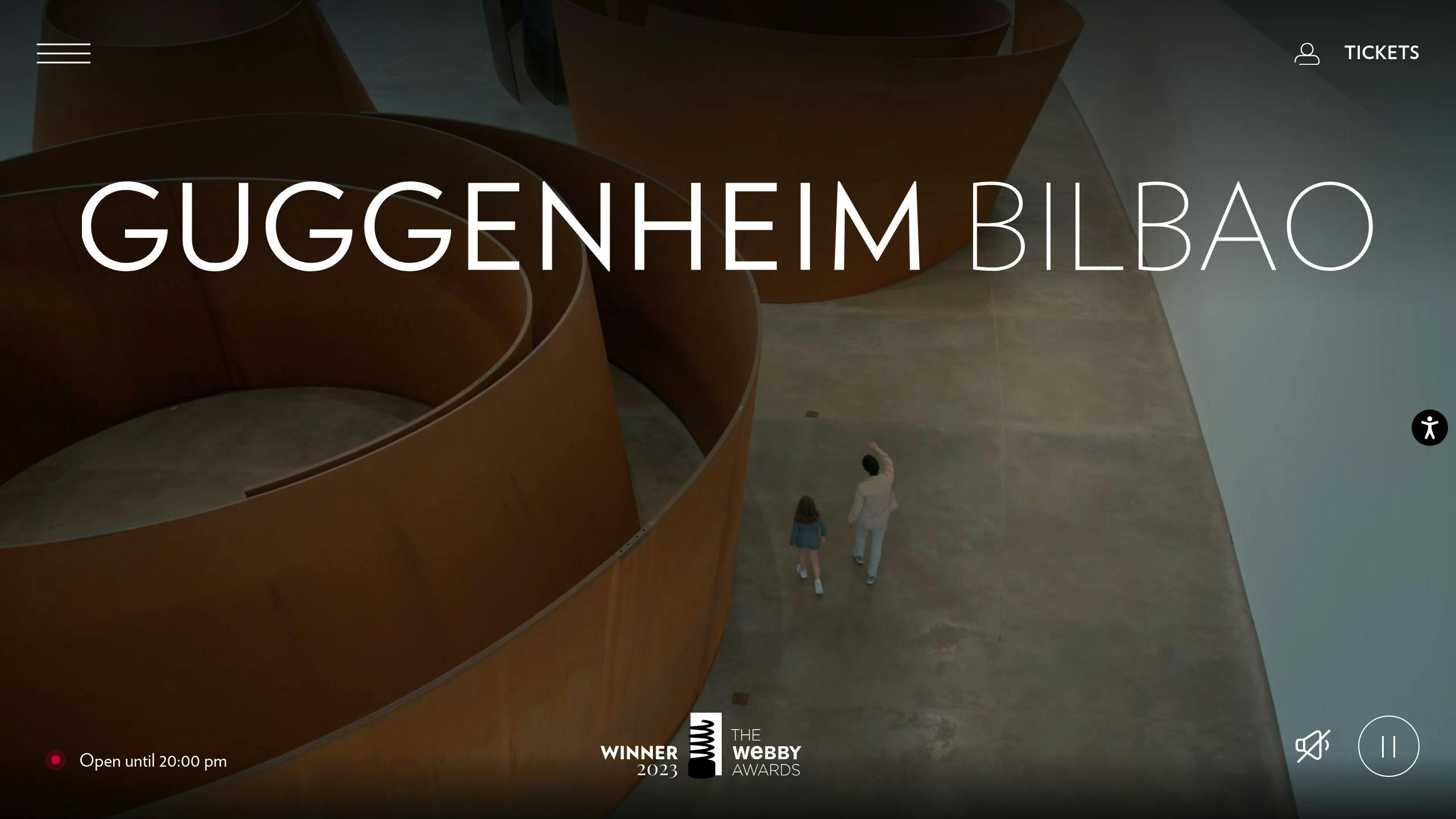
The Guggenheim Museum Bilbao isn't just a building. It's a game-changer.
Opened in 1997, this museum didn't just give Bilbao, Spain a new place to hang art. It gave the city a whole new life.
| Before Guggenheim | After Guggenheim |
|---|---|
| Struggling tourism | 1 million visitors yearly |
| Declining industry | $500 million boost in 3 years |
| Industrial city image | Global cultural hotspot |
Frank Gehry's design? It's not your average museum.
He used CATIA, a 3D design program, to create shapes that were once impossible. The building's skin? A mix of titanium, limestone, and glass that plays with light in wild ways.
And get this: it looks like a boat on the Nervión River, tying into Bilbao's history.
The Guggenheim didn't just change Bilbao's skyline. It changed how we think about museums:
- It kicked off the "Bilbao Effect" - the idea that a cool building can boost a city's economy and image.
- It's hosted over 100 exhibitions, pulling in art lovers from everywhere.
- 21 million visitors since opening? That's not just a museum. That's a phenomenon.
Now, the Guggenheim is a global icon. Cities worldwide try to copy its success, but few come close. It's as famous for its architecture as it is for the art inside.
Frank Gehry said it best: "There's a whole feeling of life that's different. It makes me feel good that we contributed to that."
The Guggenheim Museum Bilbao proves that a bold building can do more than stand tall. It can lift an entire city.
How Famous Buildings Boost Tourism and Local Business
Famous buildings aren't just pretty faces. They're economic powerhouses. Here's how:
1. Tourist Magnets
Famous buildings pull in crowds. Take the Sydney Opera House:
| Impact | Numbers |
|---|---|
| Annual visitors | Millions |
| Yearly economic boost | $700 million |
| Total value | Over $4 billion |
These tourists need beds, meals, and souvenirs. That's a win for hotels, restaurants, shops, and tour guides.
2. Job Creation
More tourists = more jobs. The math checks out:
- 8.5% more jobs near national monuments
- 10% more businesses in these areas
3. City Makeovers
One building can flip a city's fortunes. Enter the Guggenheim Museum in Bilbao:
| Before Guggenheim | After Guggenheim |
|---|---|
| Struggling economy | $500 million boost in 3 years |
| Low tourism | 1 million visitors yearly |
Frank Gehry's design didn't just build a museum. It sparked the "Bilbao Effect".
4. Local Business Boost
It's not all about the big attractions. Local shops get a piece of the pie too:
- Construction crews buy local
- New tourist-focused businesses pop up
- Existing shops see more foot traffic
5. Government Revenue
More tourism means more tax dollars. That can fund better roads, services, and public spaces. The Guggenheim? $100 million in taxes in its first three years.
6. Long-Term Growth
These benefits stick around. Areas with protected landmarks see higher income and wealth over time.
Conclusion
Famous buildings are more than just pretty structures. They're economic powerhouses, cultural icons, and links to our past.
Why do they matter? Let's break it down:
1. They boost the economy
The Sydney Opera House isn't just a cool building. It's a money-making machine. It pulls in millions of visitors each year and adds $700 million to the economy annually.
2. They create jobs
Areas near famous buildings see an 8.5% jump in jobs and a 10% increase in businesses. That's a big deal for local communities.
3. They can transform cities
Ever heard of the "Bilbao Effect"? The Guggenheim Museum turned a struggling city into a hotspot with 1 million yearly visitors.
4. They connect us to history
These buildings help simplify complex histories. They're like a bridge to our past.
5. They can be eco-friendly
Fixing up old buildings is often better for the planet than building new ones. It supports local economies and cuts down on waste.
But it's not all smooth sailing. Famous buildings face some tough challenges:
| Challenges | Opportunities |
|---|---|
| High preservation costs | Finding new uses for old buildings |
| Changing cultural views | Adding cool tech |
| Environmental worries | Making buildings more eco-friendly |
So, what's next for these iconic structures?
- Old buildings might find new life. Imagine a steelworks turned into a children's library (it's real, check out Niños Conarte in Mexico).
- They'll likely focus more on being green and energy-efficient.
- Tech could make visits more exciting and help with preservation.
- We might see more diverse figures represented. Right now, only 3 of the top 50 most memorialized historical figures in America are women, and 3 are Black or indigenous men.
Paul Farber from Monument Lab says: "Monuments elevate figures and stories without the deeper work of reckoning with the past." This hints at a future where famous buildings might tell more complete, nuanced stories.
In short, famous buildings aren't just relics of the past. They're shaping our present and future in big ways.
FAQs
What are 5 famous buildings?
Here's a quick rundown of 5 world-famous buildings:
- Taj Mahal: India's marble masterpiece
- Eiffel Tower: Paris's iron icon
- Burj Khalifa: Dubai's sky-scraping giant
- Colosseum: Rome's ancient arena
- Empire State Building: New York's Art Deco legend
Each has a story:
| Building | Fun Fact |
|---|---|
| Taj Mahal | Built as a love letter in stone (1631-1653) |
| Eiffel Tower | Over 300 million visitors since 1889 |
| Burj Khalifa | Tallest building on Earth at 828.9 meters |
| Colosseum | Could fit 50,000 spectators (built 72-80 AD) |
| Empire State Building | Once the world's tallest (built 1930) |
What is the most famous architectural?
Picking the "most famous" building? That's like choosing your favorite child. But here are some top contenders:
- Taj Mahal: Often called the world's most beautiful building
- Eiffel Tower: Paris's iron celebrity
- Burj Khalifa: The tallest kid on the block
- Colosseum: Ancient Rome's architectural flex
- Sagrada Familia: Barcelona's never-ending masterpiece
These aren't just pretty faces. They're economic powerhouses. Take the Sydney Opera House - it pumps $700 million into Australia's economy every year. Not bad for a bunch of fancy shells, right?
Famous buildings do more than just look good in selfies. They create jobs, boost local economies, and connect us to our past. They're like time machines made of stone, steel, and glass.
